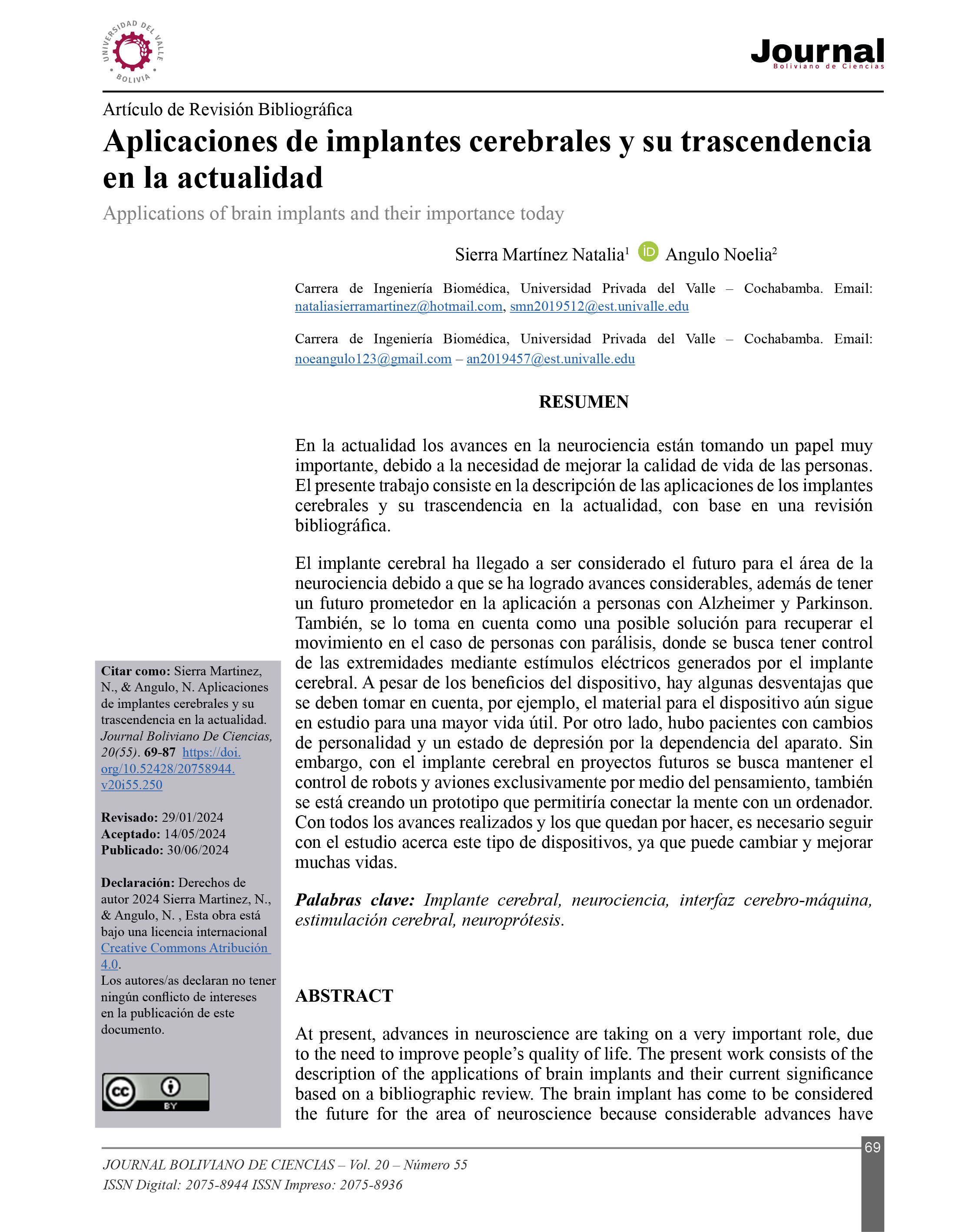Applications of brain implants and their importance today
DOI:
https://doi.org/10.52428/20758944.v20i55.250Keywords:
Implante cerebral, neurociencia, interfaz cerebro-máquina, estimulación cerebral, neuroprótesisAbstract
At present, advances in neuroscience are taking on a very important role, due to the need to improve people's quality of life. The present work consists of the description of the applications of brain implants and their current significance based on a bibliographic review. The brain implant has come to be considered the future for the area of neuroscience because considerable advances have been made, in addition to having a promising future in application to people with Alzheimer's and Parkinson's. It is also taken into account as a possible solution to recover movement in the case of people with paralysis, where it is sought to have control of the extremities through electrical stimuli generated by the brain implant. Despite the benefits of the device, there are some disadvantages that must be taken into account, for example, the material for the device is still under study for a longer service life. On the other hand, there were patients with personality changes and a state of depression due to dependence on the device. However, with the brain implant in future projects it is sought to maintain control of robots and airplanes exclusively through thought, a prototype is also being created that will allow connecting the mind with a computer. With all the advances made and those that remain to be made, it is necessary to continue with the study of this type of device, since it can change and improve many lives.
Downloads
References
Albright, T. D., Kandel, E. R., & Posner, M. I. (2000). Cognitive Neuroscience. doi: https://doi.org/10.1016/S0959-4388(00)00132-X.
https://doi.org/10.1016/S0959-4388(00)00132-X
PMid:11084324
https://doi.org/10.1016/S0959-4388(00)00132-X
https://doi.org/10.1016/S0959-4388(00)00132-X DOI: https://doi.org/10.1016/S0959-4388(00)00132-X
PMid:11084324
Alrumiah S. S, Alhajjaj L. A, Alshobaili J. F, Ibrahim DM Una revisión sobre la interfaz cerebro-computadora (BCI) Spellers: P300 Speller. Biosc.Biotech.Res.Comm. 2020; 13 (3).
https://doi.org/10.21786/bbrc/13.3/31
https://doi.org/10.21786/bbrc/13.3/31
https://doi.org/10.21786/bbrc/13.3/31 DOI: https://doi.org/10.21786/bbrc/13.3/31
Asaad, W., Foote, K., Anderson, W., Beasley, K., Reymers , D., & Ponce , F. (2016). Estimulación cerebral profunda bilateral del fórnix para la enfermedad de Alzheimer: seguridad quirúrgica en el ensayo ADvance. Journal of Neurosurgery, 125(1), 1-238.
Barral, M. (5 de diciembre de 2017). Heraldo. Obtenido de Heraldo: https://www.heraldo.es/noticias/sociedad/2017/12/05/implantes-cerebrales-para-ampliar-capacidades-1212001-310.html?autoref=true
Belandria, S. (23 de agosto de 2019). El Ciudadano. Obtenido de El Ciudadano: https://www.elciudadano.com/ciencia-tecnologia/cientificos-crean-un-dispositivo-capaz-de-manipular-neuronas-cerebrales-desde-un-smartphone/08/13/
Bettinger, C. (24 de mayo de 2018). Interfaces neuronales ultracompatibles basadas en hidrogel fabricadas mediante impresión por microtransferencia en fase acuosa. Advanced funtional materials, 28(29), 180-. doi:10.1002/adfm.201801059.
https://doi.org/10.1002/adfm.201801059
https://doi.org/10.1002/adfm.201801059
https://doi.org/10.1002/adfm.201801059 DOI: https://doi.org/10.1002/adfm.201801059
Bouton, C. (9 de marzo de 2020). Fusionando la interfaz cerebro-computadora y las tecnologías de estimulación eléctrica funcional para la restauración del movimiento. Obtenido de Fusionando la interfaz cerebro-computadora y las tecnologías de estimulación eléctrica funcional para la restauración del movimiento: https://www.sciencedirect.com/science/article/pii/B9780444639349000226
Bouton, C. (26 de enero de 2021). Los implantes cerebrales y los wearables permiten que las personas paralíticas se muevan de nuevo. Obtenido de Los implantes cerebrales y los wearables permiten que las personas paralíticas se muevan de nuevo: https://spectrum.ieee.org/biomedical/bionics/brain-implants-and-wearables-let-paralyzed-people-move-again
Carey, B. (10 de febrero de 2018). The New York Times. Recuperado el abril de 2021, de The New York Times: https://www.nytimes.com/es/2018/02/10/espanol/implante-cerebral-memoria-mejorar.html
Chen, Á. (30 de mayo de 2018). El objetivo final es el implante que dura para siempre. Obtenido de El objetivo final es el implante que dura para siempre: https://www.theverge.com/2018/5/30/17408852/brain-implant-materials-neuroscience-health-chris-bettinger
Corralejo, R. (2012). Brain-computer interface (BCI) aplicado al entrenamiento cognitivo y control domótico para prevenir los efectos del envejecimiento. Obtenido de Brain-computer interface (BCI) aplicado al entrenamiento cognitivo y control domótico para prevenir los efectos del envejecimiento: http://www.fgcsic.es/lychnos/es_ES/articulos/Brain-Computer-Interface-aplicado-al-entrenamiento-cognitivo
Drew, L. (25 de julio de 2019). Technologies that integrate the brain with computers have been helping people for decades. The brain outlook, 571(1), 19-21. Obtenido de https://media.nature.com/original/magazine-assets/d41586-019-02214-2/d41586-019-02214-2.pd
Falgas Martínez, N. (9 de abril de 2018). Alzheimer. Obtenido de Alzheimer: https://www.clinicbarcelona.org/asistencia/enfermedades/alzheimer/definicion
Granados, A. (21 de noviembre de 2015). Computerworld university. Recuperado el abril de 2021, de Computerworld university: https://www.computerworlduniversity.es/actualidad/ensayo-de-implante-cerebral-en-caltech-permite-mover-un-brazo-mecanico
Hamzelou, J. (13 de noviembre de 2017). New scientist. Obtenido de New scientist: https://www.newscientist.com/article/2153034-brain-implant-boosts-human-memory-by-mimicking-how-we-learn/
Horgan, J. (2005). The bionic age begins. Discover magazine,110(13), 36-37.
Hornero Sánchez, R. (2013). Aplicación de sistemas BCI al entrenamiento cognitivo y al control domótico para prevenir los efectos del envejecimiento. Clínica, 5(1), 2-3.
Institut Guttmann. (2 de octubre de 2018). Innovación clínica en neurorrehabilitación. Obtenido de Innovación Clínica en neurorrehabilitación: http://www.guttmanninnova.com/procedimentos-clinicos-avanzados/neuroprotesis/que-son-las-neuroprotesis.html
Lineberry, D. (2017). Neuronas en el trabajo. Obtenido de Neuronas en el trabajo: https://www.nasa.gov/centers/langley/news/researchernews/rn_BCI.html
Maguire, G., & McGee, E. (2010). Chips cerebrales implantables: Revista de humanidades, 20(2), 134-137.
Marqués, F. L. (14 de enero de 2021). https://clinic-cloud.com/blog/origen-de-la-medicina-principales-avances-medicos/. Obtenido de https://clinic-cloud.com/blog/origen-de-la-medicina-principales-avances-medicos/
Marte, H. (20 de septiembre de 2019). Implantes cerebrales: El futuro de la BCI. Obtenido de Implantes cerebrales: El futuro de la BCI: https://neuro-class.com/implantes-cerebrales-el-futuro-de-las-bci/c
Martín, B. (30 de octubre de 2019). Los extraordinarios cambios de personalidad causados por implantes cerebrales. Obtenido de Los extraordinarios cambios de personalidad causados por implantes cerebrales: https://www.bbvaopenmind.com/ciencia/biociencias/los-extraordinarios-cambios-de-personalidad-causados-por-implantes-cerebrales/
Moreno, I., Batista, E., Serracín, S., Moreno, R., Gómez, L., & Boya, C. (2019). Los sistemas de interfaz cerebro-computadora basado en EEG: características y aplicaciones. Revista Académica UTP, 12(4), 13-14.
https://doi.org/10.33412/idt.v15.2.2230
https://doi.org/10.33412/idt.v15.2.2230
https://doi.org/10.33412/idt.v15.2.2230 DOI: https://doi.org/10.33412/idt.v15.2.2230
Moya, A., & Peretó, J. (2011). Simbiosis: Seres que evolucionan juntos. Obtenido de https://www.casadellibro.com/libro-simbiosis-seres-que-evolucionan-juntos/9788497567343/1838536
Muccio, P. (marzo de 2005). Neuroprosthetics: The next generation of o&p services. Obtenido de Neuroprosthetics: The next generation of o&p services: https://opedge.com/Articles/ViewArticle/2005-03-01/2005-03_06?spanish=True
Musk, E. (2019). Future and heathcare. Obtenido de Future and heathcare: https://www.future-healthcare.ec/es/insights/85-implantes-cerebrales-el-futuro-de-la-interfaz-hombre-maquina.html
Naufel , S., & Klein , E. (2020). Perspectivas de los investigadores de la interfaz cerebro-computadora (BCI) sobre la propiedad y privacidad de los datos neuronales. Journal of Neural Engineering, 12(9)16-21.
Nicolelis, M., Doherty, J., Fitzsimmons, N., & Hanson, T. (1 de septiembre de 2009). A brain-machine interface instructed by direct intracortical. Intrgrative neuroscience, 3(20), 1-3. doi:10.3389/neuro.07.020.2009
https://doi.org/10.3389/neuro.07.020.2009
PMid:19750199 PMCid:PMC2741294
https://doi.org/10.3389/neuro.07.020.2009
https://doi.org/10.3389/neuro.07.020.2009 DOI: https://doi.org/10.3389/neuro.07.020.2009
PMid:19750199 PMCid:PMC2741294
Parkinson's Foundation. (2021). Parkinson's Foundation. Obtenido de Parkinson's Foundation: https://www.parkinson.org/Understanding-Parkinsons/Treatment/Surgical-Treatment-Options/Deep-Brain-Stimulation#:~:text=Uses%20a%20surgically%20implanted%2C%20battery,cause%20tremor%20and%20PD%20symptoms.
Pastor, J. (9 de enero de 2015). Xacata. Recuperado el abril de 2021, de Xacata: https://www.xataka.com/investigacion/los-implantes-cerebrales-podran-ser-mas-duraderos-gracias-a-estos-electrodos-elasticos
Ponce, F. (11 de marzo de 2016). El implante electrónico estimula el cerebro de los pacientes con Alzheimer. Obtenido de El implante electrónico estimula el cerebro de los pacientes con Alzheimer: https://www.salud.carlosslim.org/english2/electronic-implant-stimulates-brain-of-alzheimers-patients/
Ramirez, A., Martinez, D., & Rodríguez, M. (2016). Estimulación cerebral profunda: Hacia la generación de los dispositivos "inteligentes". Revista Mexicana de Neurociencia, 17(4), 67-97.
Ramos-Argüelles, F., Morales, G., Egozcue, S., Pabón, R., & Alonso, M. (2009). Técnicas básicas de electroencefalografía: principios y aplicaciones clínicas. Obtenido de Técnicas básicas de electroencefalografía: principios y aplicaciones clínicas: https://scielo.isciii.es/scielo.php?script=sci_arttext&pid=S1137-66272009000600006
https://doi.org/10.4321/S1137-66272009000600006
https://doi.org/10.4321/S1137-66272009000600006
https://doi.org/10.4321/S1137-66272009000600006 DOI: https://doi.org/10.4321/S1137-66272009000600006
PMid:20094087
Ranchal, J. (2 de febrero de 2021). Mcpro. Obtenido de Muy computer pro: https://www.muycomputerpro.com/2021/02/02/neuralink-cerebro-computadora
Sejnowski, T. J., Koch, C., & Churchland, P. S. (1988). Neurociencia Computaciona. Science, 29(10), 1299-1306.
https://doi.org/10.1126/science.3045969
PMid:3045969
https://doi.org/10.1126/science.3045969
https://doi.org/10.1126/science.3045969 DOI: https://doi.org/10.1126/science.3045969
PMid:3045969
Simeral, J., Kim, S., Black, M., Donoghue, J., & Hochberg, L. (2011). Control neuronal de la trayectoria del cursor y clic por un humano con tetraplejía 1000 días después del implante de una matriz de microelectrodos intracorticales. Journal of Neural Engineering,28(15), 25-27.
Song, A. (30 de agosto de 2020). La Voz de Galicia. Obtenido de La Voz de Galicia: https://www.lavozdegalicia.es/noticia/cultura/2020/08/29/elon-musk-anuncia-avances-sobre-implante-cerebral/00031598720455738842443.htm#:~:text=El%20implante%20cerebral%20que%20permitir%C3%ADa,futuro%20cada%20vez%20m%C3%A1s%20cercano.

Published
How to Cite
Issue
Section
License
Copyright (c) 2024 Natalia Sierra Martinez, Noelia Angulo

This work is licensed under a Creative Commons Attribution 4.0 International License.
Authors who publish with this journal agree to the following terms:
- Authors retain copyright and grant the journal right of first publication with the work simultaneously licensed under a Creative Commons Attribution License 4.0 that allows others to share the work with an acknowledgement of the work's authorship and initial publication in this journal.
- Authors are able to enter into separate, additional contractual arrangements for the non-exclusive distribution of the journal's published version of the work (e.g., post it to an institutional repository or publish it in a book), with an acknowledgement of its initial publication in this journal.
- Authors are permitted and encouraged to post their work online (e.g., in institutional repositories or on their website) prior to and during the submission process, as it can lead to productive exchanges, as well as earlier and greater citation of published work.














